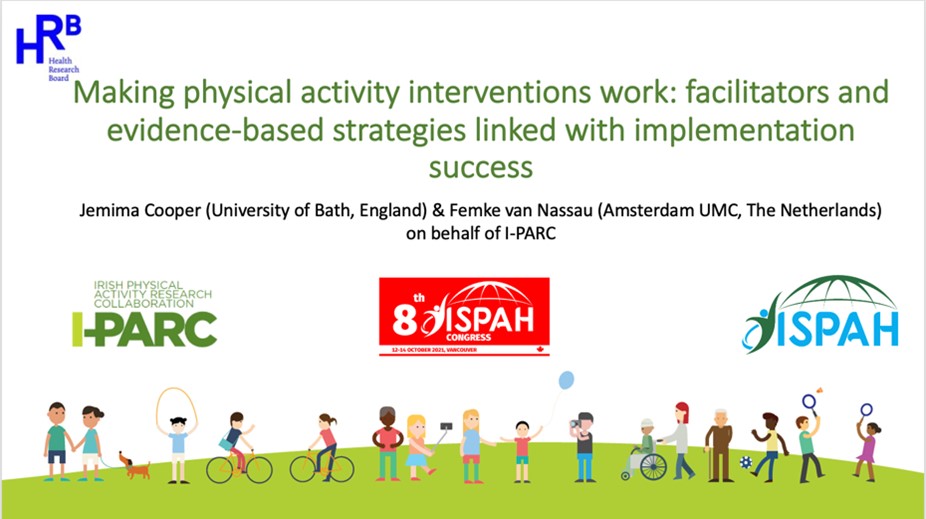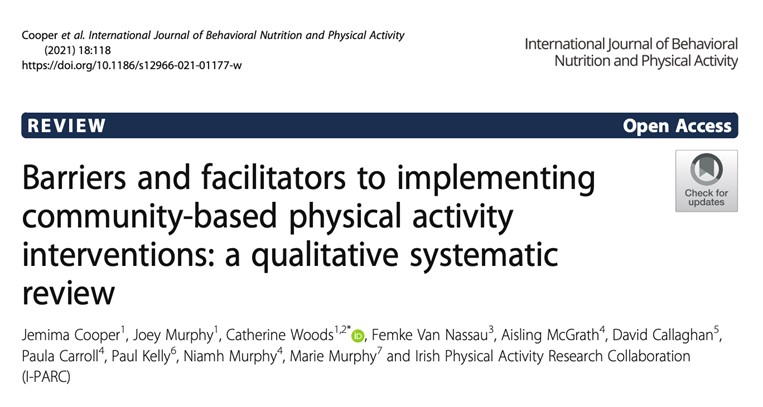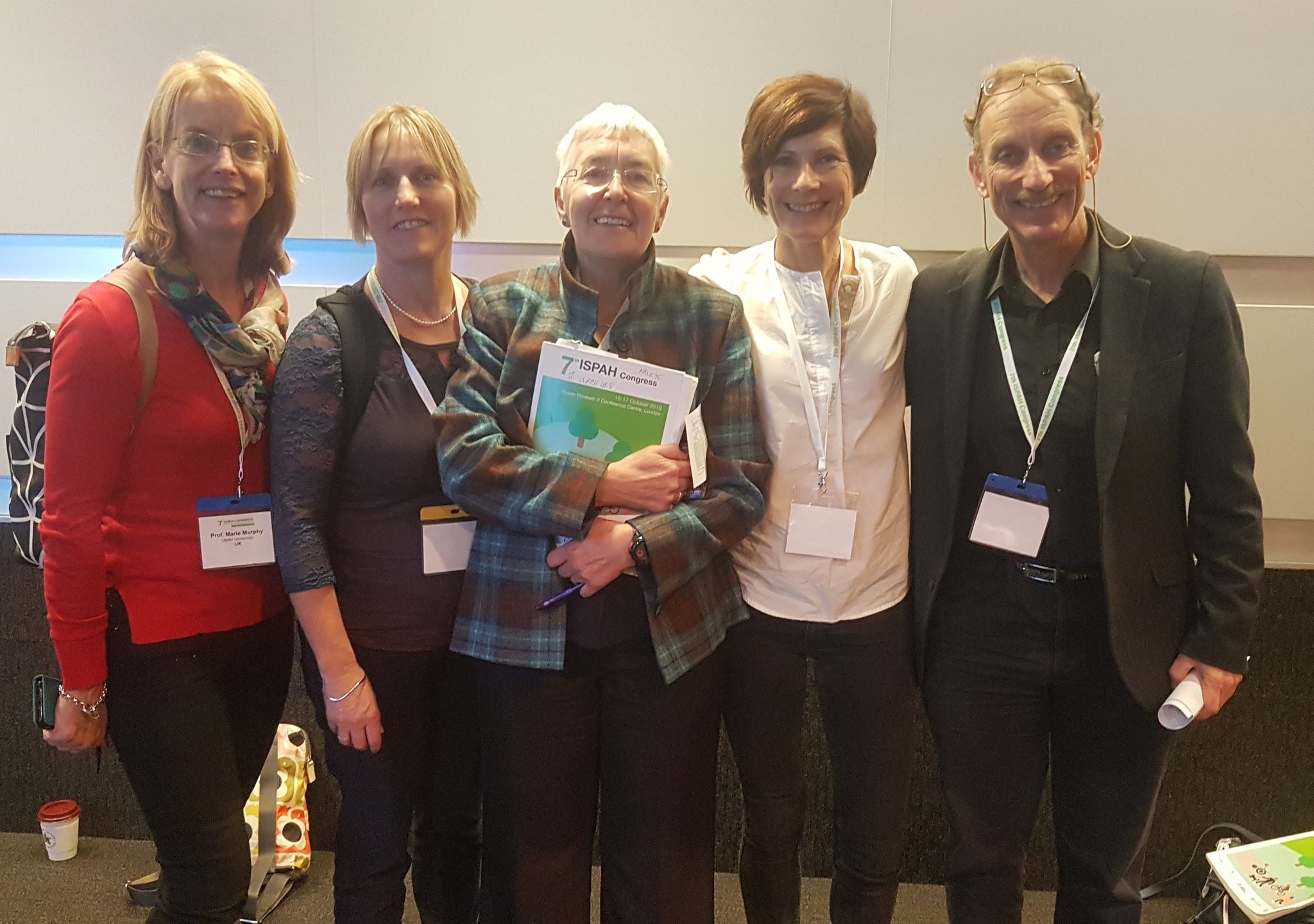Featured Blog – “Barriers and facilitators to implementing community-based physical activity interventions: a qualitative systematic review”


A qualitative systematic review from I-PARC was published in the International Journal for Behavioural Nutrition and Physical Activity in September 2021. The aim of the review was to report on facilitators and barriers of implementation for interventions which promote physical activity in community-based settings. A secondary aim was to provide recommendations to improve implementation identified within the included studies. This secondary aim was partially inspired by the work that I-PARC does, by aiming to make research translatable beyond academia and inform practice. This review included only qualitative data, from a mix of qualitative studies and mixed methods studies. This is quite unique for a systematic review, but the author team chose a qualitative approach, as it allows for in-depth insight into individual’s perceptions of the barriers and facilitators that are relevant to their context, and is increasingly recognised as an important approach for developing the evidence base in PA and implementation research.
The findings of the qualitative review were presented at the International Society for Physical Activity and Health (ISPAH) 2021 conference hosted virtually in Vancouver, as part of an I-PARC symposium. 179 people registered to attend I-PARC’s symposium, titled I-PARC: A whole of system approach for enhancing effective interventions, implementation strategies, and enabling contexts to reduce population levels of physical inactivity. The review findings were presented as part of session 3 – Making physical activity interventions work: facilitators and evidence-based strategies linked with implementation success.

The use of a theoretical framework was integral to this review, and it was used to extract qualitative data and analyse results. The Consolidated Framework for Implementation Research (CFIR) (Damschroder et al., 2009) was chosen, as it synthesises multiple implementation theories into accessible domains and constructs that are practical and easily applicable to the area of PA intervention research. The framework consists of 39 constructs across five domains including 1) intervention characteristics, 2) inner setting, 3) outer setting, 4) individual characteristics and 5) processes of implementation. In the session presented at ISPAH, we discussed two domains that the review highlights as crucial on a broader scale:
Inner setting:
- We identified more barriers than facilitators. This contrasts with all other CFIR domains, and indicates that during the implementation process, the inner setting is of key importance.
- Several barriers in inner setting have multiple consequences which impact on, and exacerbate, other barriers. For instance, staff burnout is a barrier to implementation which may also contribute to high staff turnover. Attempting to address barriers in the inner setting can reduce this potential negative domino effect.
- Our findings support other evidence that inner setting factors, such as a lack of resources and appropriately trained staff members, can greatly affect how interventions are implemented, which is why this domain can hold the key to PA intervention implementation success
Individual Characteristics:
- We found that individual characteristics are an often-overlooked domain within implementation research, and as such, the impact of the role of individuals in the successful implementation of an intervention are undervalued. There is a lack of consideration when developing implementation strategies for the need to create buy-in and change from individuals at all levels of responsibility within an organisation.
- When individuals implementing the intervention perceive a sense of reward and recognise the value of the intervention, these act as key facilitators. Inner and outer setting factors could be contributing to individual characteristics being undervalued, as barriers such as high staff turnover, poor staff training quality, lack of communication within teams, and poor relationship between community and organisation all contribute to the inability to invest in individual-level capacity building.
Overall findings:
Facilitators in one domain support those in another, and at the core of that support is the individuals at the different levels within an organisation, from providers through to leadership level, and other key stakeholders such as participants, external funders and community leaders.
Recommendations:
As discussed, the secondary aim of this review was to collate recommendations from articles included in the review. The first recommendation is that implementers need to give careful consideration to the way interventions are delivered, and the importance of negotiated planning. Several frameworks now exist to aid in the development and planning stage of an intervention, but there is a lack of evidence of the effectiveness of existing implementation strategies, and further research to test these strategies is needed. The second recommendation is the suggestion that more attention is needed for the individuals implementing intervention, such as providers who interact with intervention participants. Increasing providers’ skills and involvement in the implementation of intervention is needed to improve provider’s self-efficacy and knowledge.
More detailed findings and further recommendations can be found by accessing the full review for free at: https://ijbnpa.biomedcentral.com/articles/10.1186/s12966-021-01177-w
In addition to being presented at an international conference, this systematic review research has been accessed 1,967 times on IJBNPA, and is in the top 5% of research outputs ever tracked by Altmetric – who specialise in tracking published research and monitoring the attention surrounding research outputs. This positive metric shows the impact that I-PARC’s research is having and how many individuals it has reached.
Blog written by Jemima Cooper
PhD Researcher at the University of Bath
Twitter: @JemimaACooper
Email: jac208@bath.ac.uk










